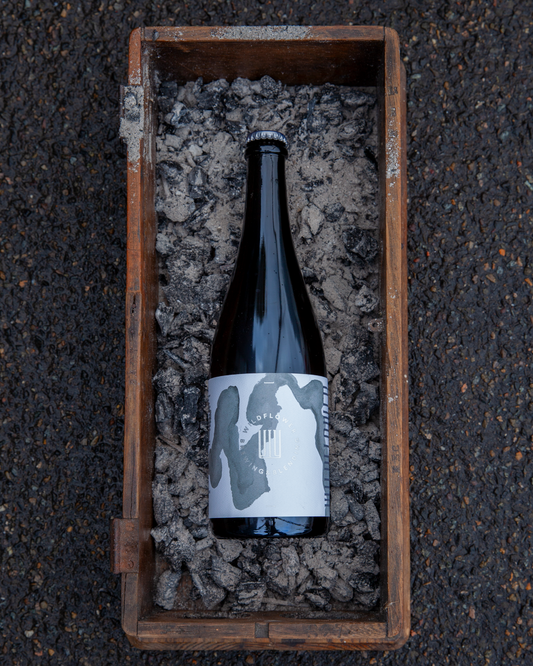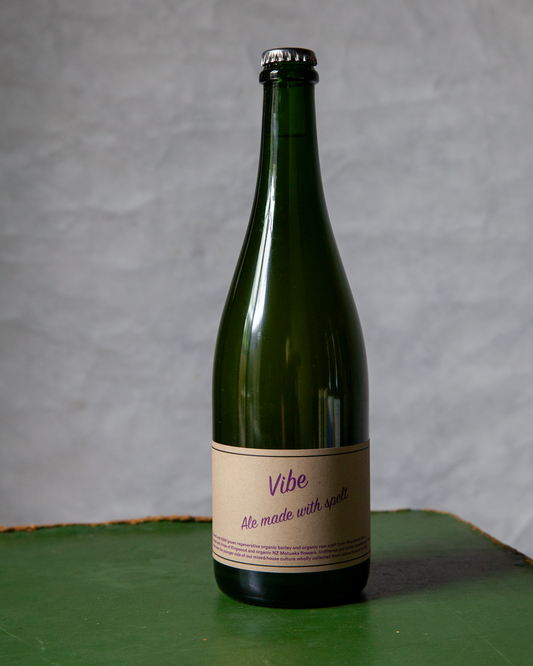This is the first post in an ongoing series. This series, 'Process', will focus one-by-one on specific elements of how we make our beer.
For the first edition of this series, I want to focus on our wide, shallow fermentation vessel that all of our beers undergo primary fermentation in. As you will see below, there is an inverse relationship between pressure on fermenting beer and ester formation. In other words, more pressure, less esters. Now this is important, and has an impact on our final beer because these esters are some of the most important aroma/flavour organic compounds we find in beer. Most specifically for yeast driven, more Franco-Belgian style beers like ours, these compounds are the major drivers of flavour rather than hops or malt.
At Wildflower, we want to encourage these flavour producers. We intentionally purchased a 3000 l wide, quite short stainless steel vessel for our primary fermentations. Primary fermentation, is, as it sounds, the initial 5-6 days of our beer's life. Unfermented beer (wort) is inoculated with our house culture of brewers yeast and wild, NSW native yeast and bugs that get to work converting sugar into alcohol and CO2. There is a bunch more stuff happening as well but pertinent to our discussion esters are also being synthesised in yeast (hooray for flavour!). In the final beer, these esters present as fruity, spicy, clove-like, pineapple, apple and heaps more aromas that are the trademark of yeast forward beers, and for the fruity characteristics in British ale.
Not only do we want to promote these trademark aromas of primary fermentation in our beer but also these esters become the building blocks for completely new ester formation by Brettanomyces and other wild yeast resident in our house culture in a process called transesterification. And this is a really cool part - because our wild yeast is truly wild, foraged from NSW, we have no idea what types of esters and in what populations will be produced... it's an entirely new creation that we get to be present for. This is largely why I say that what we do at Wildflower is prepare the right conditions for our yeast and let mother nature do the rest.
Yvan de Baets, owner of famed Brasserie de la Senne, opened my eyes to this important biochemical phenomena when I was touring his brewery in 2015. I wrote about it then but wanted to touch on it again from my current perspective a dozen or so batches into using this type of fermenter. What follows is a slightly technical discussion on CO2, esters, their formation and some pathways for ester creation. I will then briefly look into the history of these types of fermentations and where you can see other examples of it in beer.
Ester Production
"The concentrations of esters and fusel alcohols formed during brewery fermentations were significantly reduced by increased carbon dioxide pressure." (Regner, 1992)
In order to understand how esters are produced, we need to quickly first talk about carbon dioxide pressure.
There are two main pressure types, hydrostatic and top, that effect the carbon dioxide pressure of a fermenting beer. Hydrostatic pressure is the pressure a diver feels when she dives deeper in the ocean. It is the combined weight of the liquid on top of you. Or more at hand, the pressure felt by beer at the bottom of a tall cylindroconical fermenter by all the beer on top of it. Top pressure is the pressure felt by a beer in a tank if there is anything limiting blowoff. For example, during fermentation CO2 bubbles out of the solution and escapes into the headspace of a tank, then down a blowoff arm into (generally) a bucket of some sort of sanitiser. It requires a small, but non-negligible amount of pressure to displace the water in an air-lock to let the blowing off CO2 pass.
So, together both of these pressures increase the total pressure felt by a fermenting beer. Now, it is not so much the pressure (units bar, atm, Pascal) that effects ester production however, more of that pressures ability to keep carbon dioxide dissolved in solution. The more pressure on the beer, the more carbon dioxide will stay dissolved in the beer instead of blowing off, out through the headspace and into your brewery. It matters because "increasing concentrations of dissolved CO2 suppress yeast growth by unbalancing decarboxylation reactions (...) which are a fundamental step in either higher alcohol or acetyl-CoA synthesis" (Pires, 2015). Pretty dense, right but just take it one more step...
In order for ester synthesis to happen, acetyl CoA (co-enzyme A) must be present. The biochemical pathway for ester synthesis in the yeast cell involves ethanol or higher alcohols, acetyl CoA and ester-synthesising enzymes. As acetyl CoA is the primary precursor, if you limit the production of yeast growth by increasing concentrations of CO2, you limit ester production. Which in our case is no good.
So, with taller fermenters and air locks you get:
↑ CO2 pressure ⇒ ↓ yeast growth ⇒ ↓ acetyl CoA synthesis ⇒ ↓ ester formation
With shorter fermenters and open-air fermentations you get:
↓ CO2 pressure ⇒ ↑ yeast growth ⇒ ↑ acetyl CoA synthesis ⇒ ↑ ester formation
It should also be noted here, that pressure is only one of many factors that effect ester production. Temperature is another very important one where higher temperature fermentations lend themselves to increased ester formation. All our beers ferment between 25-35C. Yeast selection, pitch rate, wort aeration... there are more factors to play with however I feel that pressure is often overlooked.
Inside our fermenter. Flat bottom and, even when totally full, under 1m height.
Importance of Esters
I cannot overstate the role of esters in beer (and pretty much all fermented beverages) as flavour components. Maybe have a look at this article from Serious Eats to understand better. While we are trying to promote ester production, these pathways have been mostly studied at attempts to limit ester production for High Gravity Brewing of lagers. In some (mostly large, lager) breweries, ester formation is not desired so fermentations are carried out under pressure.
However, for us, in long complex fermentations these little compounds become the subjects themselves to chemical reactions that create brand new esters. In his Blog, Sour Beer Blog, Matt Miller covers this process better than I think I would be able to. But for us the creation of new esters through transesterification really gets us excited. Because we don't know what types of esters and acids in what quantities will be produced by our culture, we are leaving ourselves very open to the production of new esters.
Around the world
Another reason for this being the first instalment on process is because I've been doing a little research/reading into the effects of pressure myself to understand open-top fermenters and their effects a bit better. This is largely driven by my interest in Bob Sylvester's practices at St Somewhere in Tarpon Springs, Florida, brought more to my attention by Jake Miller of Heirloom Rustic Ales (coming soon) in Tulsa, Oklahoma.
Open-top fermentations (non-sealed vessels not necessarily spontaneous/wild) would have been the norm in brewing for a great number of years. They are still quite common in England where the fruity British yeast thrives without pressure. Notably the Kernel started off with them, gave those FV's to Partizan and now with Josh Wheeler at Cyclic Beer farm in Barcelona has those same open-top tanks! I believe open fermentations also make beer with a softer mouthfeel (look at Reid's beer at New England Brewing). In the states, Burial in Asheville has a wide UFO looking tank for their saisons and I know of many more open-fermentation projects going on too.
________________________________________________
I am coming to realise more and more that the dynamics of your brewhouse, fermentation vessel and other brewery equipment are inextricably tied to the type of beer that you end up making. At Wildflower we want to focus on mixed-culture old-world yeast driven beers and our wide primary fermentation tank is one small element of making that happen.
best,
topher
Landaud, S. Top Pressure and Temperature Control the Fusel Alcohol/Ester Ratio through Yeast Growth in Beer Fermentation. J. Inst. Brew. 2000.
Pires, E. and Brányik, T. Biochemistry of Beer Fermentation. 2015.
Regner, R. S., et al. The Formation of Esters and Higher Alcohols During Brewery Fermentation; The Effect of Carbon Dioxide Pressure. J. Inst. Brew. 1992




